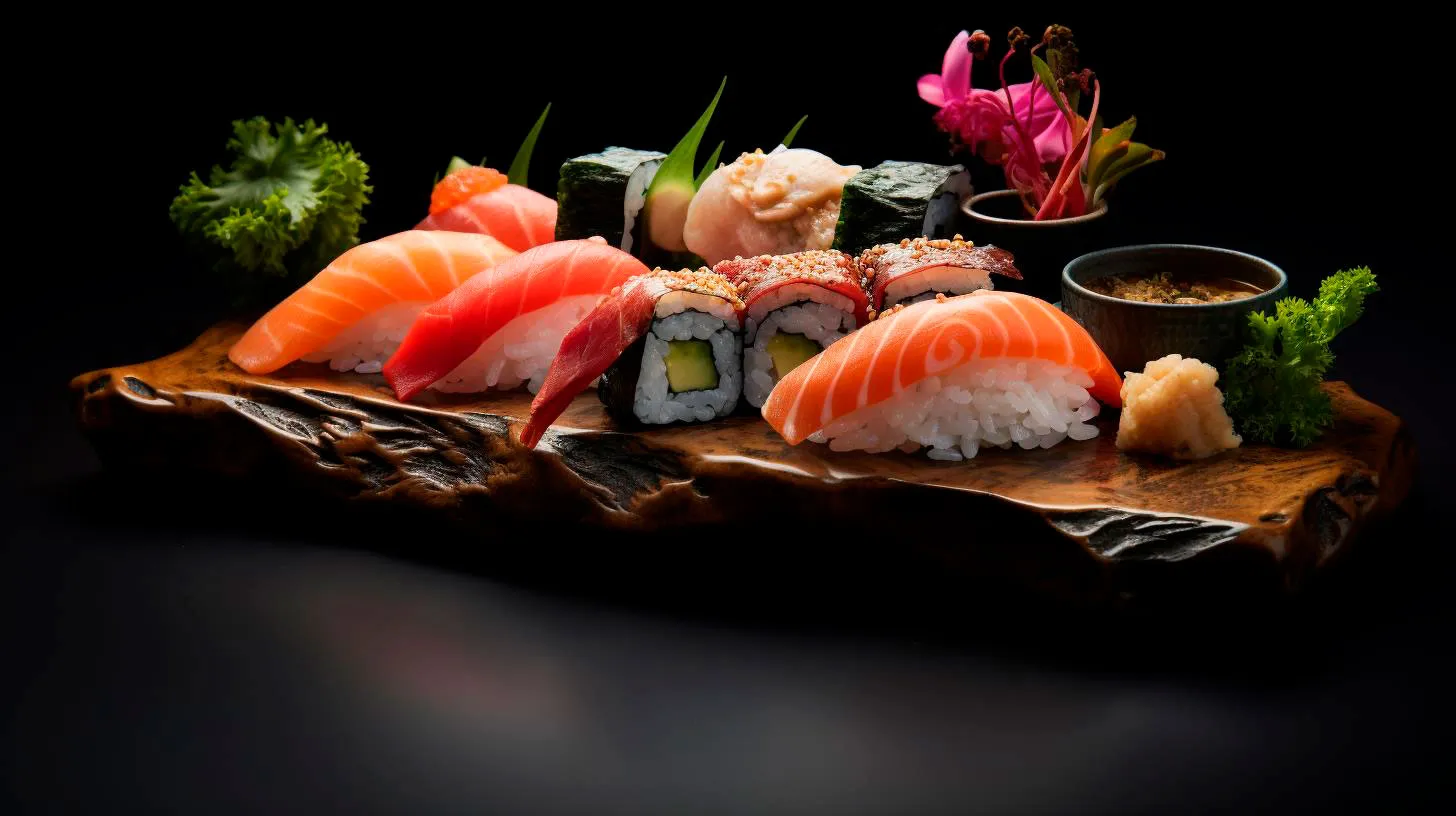The Art of Sushi Rice: Mastering the Foundation of Culinary Creativity
The perfect balance of flavor, texture, and stickiness in sushi rice is what sets extraordinary sushi apart from the ordinary. Join us as we dive into the art of sushi rice and explore the secrets to mastering this foundation of culinary creativity.
The Importance of Sushi Rice
Before we delve into the intricate details of sushi rice preparation, it’s essential to understand why it is of utmost importance in sushi making. The rice serves as the canvas on which the other ingredients, such as fish, vegetables, or seaweed, are artfully arranged. It provides a harmonious balance of flavors, complementing the various fillings in each bite. Sushi rice also acts as a glue, ensuring that the roll holds together, allowing for easier handling and consumption.
Key Takeaways:
- Sushi rice is the foundation of every sushi roll, providing flavor, texture, and stickiness.
- It serves as a canvas for other ingredients and acts as a binder for easy consumption.
The Perfect Sushi Rice: A Delicate Balance
Achieving the perfect sushi rice might seem like an art form in itself because it requires precision and attention to detail. The delicate balance lies in achieving a rice that is sticky enough to hold together but not overly so that it becomes clumpy and unpalatable. Additionally, the rice should have a subtle sweetness and a slightly vinegary taste to harmonize with the other components.
Here’s a step-by-step guide to mastering the art of sushi rice:
1. Rice Selection
The type of rice used in sushi making is crucial. Opt for short-grain Japanese rice, as it is specially cultivated to provide the perfect texture and stickiness required for sushi. This type of rice can be easily found in most grocery stores or specialty Asian markets.
2. Rinse and Soak
Thoroughly rinse the rice under cold water until the water runs clear. This step removes excess starch, ensuring the rice doesn’t become overly sticky. After rinsing, allow the rice to soak in water for about 30 minutes. This helps the grains absorb water evenly for a consistent texture.
3. Cooking
In a heavy-bottomed pot, combine the soaked rice and water in a ratio of 1:1.1, respectively. Bring the mixture to a boil, then reduce the heat to low, cover, and let it simmer for about 15 minutes. Remove from heat and let it steam for an additional 10 minutes, allowing the rice to fully cook and absorb any remaining moisture.
4. Vinegar Mixture
While the rice is cooking, prepare the vinegar mixture. In a small saucepan, combine rice vinegar, sugar, and salt. Gently heat the mixture until the sugar and salt dissolve, but avoid boiling it. Once dissolved, set the vinegar mixture aside to cool.
5. Seasoning the Rice
Transfer the cooked rice to a wooden or non-metallic bowl. Gradually pour the vinegar mixture over the rice, using a wooden spatula or paddle to gently fold and mix the rice. Be careful not to crush the grains, as the rice should retain its individual shape.
Cool the seasoned rice by fanning it with a handheld fan or using a fan on a low setting. This process removes excess moisture and gives the rice its characteristic glossy appearance.
Key Takeaways:
- Proper rice selection and rinsing are vital for achieving the desired texture.
- Master the cooking process to ensure evenly cooked rice.
- The vinegar mixture adds the perfect balance of sweetness and acidity to the rice.
The Role of Sushi Rice in Sushi Artistry
Now that you have a foundation in sushi rice preparation, let’s explore the role it plays in elevating the artistry of sushi making.
1. Nigiri Sushi
Sushi rice is the star of Nigiri sushi, where a small mound of seasoned rice is topped with fresh fish or other ingredients. The rice’s stickiness helps the toppings adhere, while its flavor subtly enhances the overall taste experience.
2. Maki Rolls
In Maki rolls, sushi rice acts as the binding agent, holding together various fillings such as vegetables, fish, or meat. Its stickiness ensures that each slice holds its shape, allowing for a pleasant and mess-free eating experience.
3. Temaki
Sushi hand rolls, known as Temaki, are made by wrapping sushi rice and various fillings in a sheet of seaweed. The well-balanced sushi rice adds the perfect texture, allowing for a satisfying crunch as you take a bite.
Key Takeaways:
- Sushi rice is the foundation for Nigiri sushi, Maki rolls, and Temaki.
- Its stickiness ensures toppings and fillings adhere and holds the rolls together.
- Sushi rice provides a pleasing texture for a memorable dining experience.
Mastering the art of sushi rice is the gateway to creating exceptional sushi. By paying attention to every detail, from rice selection to the delicate balancing act of flavor and texture, you’ll be well on your way to mastering this culinary foundation. So, take a chance, experiment with flavors, and let your sushi rice become the canvas for your culinary creativity!
Unlocking the Secrets of Sushi Rice: Crafting a Canvas for Culinary Artistry
In this article, we will delve into the secrets of sushi rice and its crucial role in crafting the ultimate sushi experience.
The Importance of Sushi Rice
When it comes to sushi, the quality of the rice is just as important as the freshness of the fish and the precision of the knife skills. Sushi rice, also known as shari, is the foundation upon which sushi is built. It binds the ingredients together, enhancing their flavors while providing the desired texture.
Sushi rice is distinct from other types of rice due to its unique characteristics. It is a short-grain variety that is stickier and more glutinous than long-grain or medium-grain rice. This stickiness allows the rice to hold its shape when formed into sushi rolls or nigiri, ensuring that each bite is cohesive and enjoyable.
Key takeaways:
- Sushi rice is the foundation of every great sushi roll.
- It enhances the flavors and provides the desired texture.
- Sushi rice is stickier and more glutinous than other types of rice.
The Secrets of Sushi Rice
Sushi rice may appear simple, but achieving the perfect balance of flavor, texture, and stickiness requires technique and attention to detail. Here are some of the secrets behind mastering sushi rice:
Quality Rice
Using high-quality sushi rice is paramount. Look for Japanese varieties such as Koshihikari or Calrose, known for their premium texture and flavor. These rice varieties have the perfect balance of starch and moisture content, enabling them to absorb the vinegar seasoning without becoming mushy.
Proper Washing and Soaking
Before cooking, it is crucial to rinse the rice under cold water until the water runs clear. This step removes excess starch, resulting in fluffier and less sticky rice. After washing, let the rice soak for about 30 minutes to allow it to absorb water evenly, which promotes even cooking.
Precise Water-to-Rice Ratio
Achieving the right water-to-rice ratio is essential. Generally, a 1:1.1 ratio works best for sushi rice. Use slightly more water than the volume of rice to compensate for evaporation during the cooking process. Consistently measuring the ratio will result in perfectly cooked rice with the ideal moisture level.
Seasoning with Vinegar
Vinegar plays a pivotal role in sushi rice’s flavor profile. Traditionally, a mixture of rice vinegar, sugar, and salt is gently heated and then combined with the cooked rice. The seasoning should be evenly distributed throughout the rice, ensuring each grain is infused with a subtle tanginess that complements the fish and other ingredients.
Key takeaways:
- Choose high-quality Japanese rice varieties like Koshihikari or Calrose.
- Rinse the rice thoroughly and let it soak for even cooking.
- Measure the water-to-rice ratio precisely for consistent results.
- Season the rice with a mixture of rice vinegar, sugar, and salt.
Advantages of Mastering Sushi Rice
Mastering the art of sushi rice opens a world of culinary possibilities. Here are the advantages of crafting exceptional sushi rice:
Superior Taste
Perfectly seasoned sushi rice complements the flavors of the fish, vegetables, and other ingredients. Each bite becomes a harmonious blend of sweet, savory, and tangy notes, elevating the overall sushi experience.
Enhanced Aesthetic Appeal
When sushi rice is well-prepared, it holds its shape, allowing the sushi chef to create visually stunning rolls. The beautiful contrast between the vibrant fish and the perfectly formed rice makes sushi a feast for the eyes.
Improved Texture
A well-crafted sushi rice provides the right level of stickiness, ensuring that the sushi roll holds together without falling apart. The perfect balance of chewiness and tenderness adds a delightful textural component to each bite.
Authenticity and Creativity
By mastering sushi rice, you gain the ability to recreate the authenticity of traditional Japanese sushi in your own kitchen. Additionally, it opens doors to experiment and innovate with unique flavor combinations, showcasing your creativity in sushi-making.
Key takeaways:
- Sushi rice enhances the taste, visual appeal, and texture of sushi.
- It adds authenticity to traditional Japanese sushi.
- Mastering sushi rice allows for creativity and innovation in sushi-making.
In conclusion, sushi rice is the unsung hero behind every great sushi dish. Mastering its preparation is an essential skill that elevates the overall sushi experience. Remember to choose high-quality rice, wash and soak it properly, measure the water-to-rice ratio precisely, and season it with care. Unlocking the secrets of sushi rice will allow you to embark on a culinary journey, creating stunning and delicious sushi masterpieces that will impress your palate and those around you.
Sushi Rice: Elevating Culinary Experiences through Nature’s Perfect Canvas
The Essence of Sushi Rice
Sushi rice, also known as shari, is a fundamental component of sushi. It forms the base and serves as a flavor carrier for various toppings like fish, vegetables, and seafood. The preparation of sushi rice requires a meticulous process that combines the right ingredients and culinary techniques.
Key Takeaway:
- Attention to detail and precision are vital in the preparation of sushi rice.
Characteristics of Sushi Rice
Sushi rice has distinct qualities that set it apart from regular rice varieties. The key characteristic is its stickiness, known as “shininess” or “glutinosity.” This stickiness allows the rice grains to hold their shape and bind the ingredients together.
Another crucial attribute of sushi rice is its slightly sweet and tangy taste, achieved by combining rice vinegar, sugar, and salt during the cooking process. This flavor profile harmonizes with the toppings and enhances the overall sushi experience.
Key Takeaways:
- Sushi rice is sticky, contributing to the structural integrity of sushi.
- Its sweet and tangy taste complements the flavors of sushi toppings.
The Art of Perfect Sushi Rice
Creating the perfect sushi rice requires precision, practice, and a keen understanding of the ingredients involved. From selecting the right rice variety to cooking and seasoning techniques, every step plays a crucial role in achieving culinary excellence.
Traditionally, short-grain Japanese rice, known as Japonica rice, is used for making sushi. The grains are plump, round, and contain the ideal starch content that provides the desired stickiness. Washing the rice thoroughly to remove excess starch and measuring the water precisely are crucial steps in achieving perfect sushi rice texture.
Once the rice is cooked, it is essential to season it with a mixture of rice vinegar, sugar, and salt while gently folding to avoid crushing the rice grains. The seasoning enhances the flavor and texture while preserving the individuality of each grain.
Key Takeaways:
- Short-grain Japonica rice is the preferred choice for sushi rice.
- Precision in measurements and techniques is crucial to achieving the perfect texture and flavor.
The Perfect Canvas for Culinary Masterpieces
Sushi rice acts as a blank canvas for sushi chefs to showcase their creativity and skills. The sticky and flavorful nature of sushi rice enables it to hold various toppings and fillings, creating a harmonious blend of tastes and textures.
Using sushi rice as a base, chefs can craft a wide variety of sushi, including nigiri (raw fish on rice), maki (rolled sushi), temaki (hand rolls), and chirashi (scattered sushi). Each of these sushi styles presents a unique combination of flavors and presentations, showcasing the versatility of sushi rice.
Key Takeaways:
- Sushi rice provides the foundation for a myriad of sushi creations.
- Its sticky texture holds the toppings and fillings together, enhancing the overall experience.
Statistics: The Popularity of Sushi
The love for sushi extends far beyond Japan, as its popularity continues to rise globally. Here are a few industry statistics that demonstrate the growing fascination with sushi:
- In 2019, the global sushi market was valued at approximately $14 billion.
- As of 2021, Los Angeles has the highest number of sushi restaurants in the world, with over 600 establishments.
- In the United States, sushi is the fastest-growing ethnic cuisine, with a growth rate of 20% per year.
These statistics underline the fact that sushi has become a culinary trend that transcends borders and cultural boundaries.
In Conclusion
Sushi rice, with its unique characteristics and flavor profile, serves as the perfect canvas for culinary masterpieces. Its stickiness, combined with the sweet and tangy taste, elevates the flavors of sushi toppings, ensuring an unforgettable dining experience. By mastering the art of sushi rice preparation, chefs can unlock endless possibilities and create exquisite sushi creations that captivate the taste buds of diners worldwide.
From Grains to Greatness: Exploring the Natural Beauty of Sushi Rice
A perfectly cooked sushi rice can elevate the entire sushi experience, adding a soft and slightly tangy base to complement the other ingredients. Join me on a flavorful journey as we explore the natural beauty of sushi rice and why it deserves more appreciation.
The Essence of Sushi Rice
Sushi rice, also known as shari, is the heart and soul of sushi. Made from short-grain Japonica rice, it possesses unique characteristics that make it ideal for sushi preparation. Sushi rice is distinctively sticky due to its higher starch content, allowing it to hold its shape when rolled or molded. Additionally, it has a subtle sweetness and a slightly acidic taste, which perfectly balances the flavors of the fish and condiments.
Sushi rice is not your typical everyday rice. It undergoes a meticulous preparation process involving washing, soaking, and cooking. The rinsing of the rice removes excess starch for a cleaner and smoother texture. Soaking the rice allows it to absorb moisture, resulting in evenly cooked grains. Finally, the cooking process, which traditionally uses a wooden or clay pot, ensures each grain achieves the perfect firmness and stickiness.
The Art of Making Sushi Rice
The preparation of sushi rice requires precision and skill to achieve the desired texture and flavor. Here’s a step-by-step guide to mastering the art of making sushi rice:
- Measure the desired amount of rice and rinse it under cold water until the water runs clear.
- Soak the rinsed rice in water for about 30 minutes to enhance its moisture absorption.
- Drain the soaked rice and transfer it to a pot. Add water in a 1:1.25 ratio (rice to water) and bring it to a boil.
- Once boiling, reduce the heat to low and cover the pot with a lid. Allow the rice to simmer for approximately 15 minutes.
- After 15 minutes, remove the pot from the heat and let it sit, covered, for an additional 10 minutes to allow the rice to fully absorb the steam.
- Using a wooden spatula or paddle, gently fluff the rice to separate the grains while gradually pouring in seasoned rice vinegar.
The result? A batch of perfectly cooked sushi rice boasting a tender yet firm texture and a delicate tang that harmonizes with every ingredient it encounters.
Unveiling the Benefits of Sushi Rice
Now that we appreciate the indispensable role of sushi rice in creating delightful sushi, let’s delve into the benefits of incorporating this remarkable grain into your diet:
1. Nutritional Excellence:
- Sushi rice is a great source of energy, thanks to its high carbohydrate content, providing fuel for your day.
- Rich in essential minerals like manganese, selenium, and magnesium, sushi rice supports proper cell function and strengthens your immune system.
- It also contains vitamin B, which helps convert the food you eat into energy, enhancing overall metabolism.
2. Gut-Friendly:
- The sticky nature of sushi rice aids digestion, ensuring that the nutrients from other ingredients are efficiently absorbed by your body.
- Due to its fermented qualities, sushi rice can promote healthy gut bacteria, contributing to a balanced digestive system.
3. Versatility and Taste:
- Sushi rice, with its subtle yet distinct flavor, can be enjoyed not only in sushi but also as a side dish or as a base for various rice bowls.
- The stickiness of sushi rice makes it easier to eat with chopsticks, enhancing the overall dining experience.
Appreciating the Natural Beauty
Just like the delicate art of sushi-making, sushi rice goes beyond its mere appearance. It is the hidden hero that binds together the culinary masterpiece we call sushi. Its natural beauty lies in its ability to harmonize with other ingredients, enhancing their flavors and textures.
Next time you enjoy a plate of sushi, remember to savor the subtle tanginess of the sushi rice and appreciate the effort that goes into perfecting every grain. From grains to greatness, sushi rice is an essential ingredient that signifies the dedication and artistry of sushi chefs worldwide.
So, let’s raise our chopsticks and pay homage to the natural beauty of sushi rice – the unsung hero behind every mouthwatering sushi creation!



